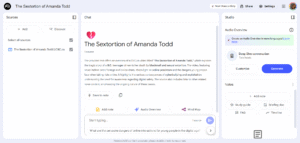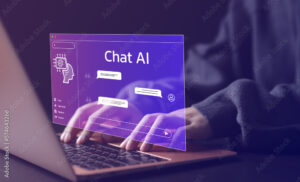Today, I decided to explore an AI tool I hadn’t tried before: Google NotebookLM . Unlike chat-based tools like ChatGBT, Google NotebookLM is designed as a personal AI “research assistant”. Individuals, especially students, can upload their own documents–articles, notes, PDFs–and then ask the AI questions about their content. It can summarize, explain, organize, or even create podcasts based on your materials. 
For the purpose of experiencing this AI tool I decided to use a document we used from class, watching the Amanda Todd documentary. 
I decided to ask a simple question about the document: What was the main message or goal of the Amanda Todd documentary?

The answer that came back was:
- What is the real story of what happen to Amanda Todd and the events that ultimately led to her death.
- To expose and highlight “the new breed of online predators”
- To raise awareness about the threats these online predators post to many young people who takes risks online.
It gave quick and short summaizes to my answer . I thought it was super helpful for visual learners and those who can’t handle reading long articles about what is being taught or learned. To go further, I also tried the podcast part. It also answered the following question above.
Please click this link and listen to the AI podcast it gave me through this website:
https://notebooklm.google.com/notebook/3e62839d-6888-4ae7-b216-2ad72b127a1b/audio
The AI-generated audio from NotebookLM sounds eerily human because it uses advanced text-to-speech technology, likely similar to what powers Google’s WaveNet or other deep learning voice models. Not only does it mimic emotion and intonation like humans, it has natural pauses and pacing making it sound like thing “person” is truly thinking or feeling the world. However, although its uncanny, it gives great advice on why Amanda Todd’s documentary is important for schools/parents to teach children about the importance of protection from online predators and what we share online.
The educational possibilities with NotebookLM are huge. Teachers could use it to:
- Summarize long readings into student-friendly language
- Create study guides or quiz questions from uploaded lessons
- Compare multiple sources and generate discussion prompts
- Finding research projects by guiding students through complex texts
Challenges to Consider
Like all AI tools, NotebookLM has its challenges. If students rely to heavily on AI to do the “thinking,” it could limit deeper engagement. Teachers also need to verify the accuracy of AI summaries–NotebookLM can sometimes misinterpret ideas or miss content. I’ve noticed a lot through AI tools of misinformation spread. It is sometimes super hard to even realize when ideas are wrong.
My Perspective on AI in Education
The future of AI in the Classroom
I see tools like NotebookLM becoming core tools in student research, especially in middle years and high school. As AI continues to progress in video, audio, text, and take over our technology. It can either go the way of being super helpful for future students such as building portfolios, research, or reflect on learning. Or it can take over students ability to be creative, have critical thinking, and be able to actually do their assignments without the necessity of technology. With this said, in ways, I am afraid of what AI will look like in future classrooms. However, as a future educator, I am willing to learn as technology progresses and do my best to protect my students digital literacy and how they use AI through their life. 







Thanks for sharing your research and and experience trying out Notebook AI.
This is a tool that I believe I’d use myself and as a tool for differentiating instruction in the classroom. The text to podcast option is what really interests me as a learning tool in the classroom. That said, I appreciate the challenge you’ve identified in that information can be misinterpreted. My general sense with any AI at this point is that as educators, we can use this tool but always need to be reviewing AI outputs before sharing with students.
I’ve appreciated how thorough and carefully outlined all your posts have been during the term. Thanks for all the insights!